Elodea aquarium plant: how to maintain and care?
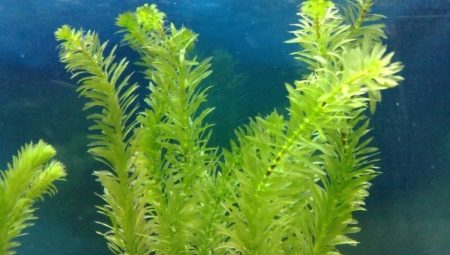
The aquarium plant Elodea is distinguished by its intensive growth and unpretentiousness, for which it received its second name - water plague. Perhaps this is the most common plant species of the Vodokrasovye family in the world aquarium hobby. Caring for elodea is quite simple, even a novice aquarist can handle it.

Description
North America is considered the birthplace of the plant. In botany, many species stand out, among which tubular, toothed, curly elodea, and denza are popular. One of the most popular is the Canadian variety, which can be seen not only in a home aquarium, but also in a pond or lake. The stems of the Canadian Elodea are long with a fragile branching structure; with age, the stem becomes more and more dark. This is a delicate plant, the structure of which is quickly destroyed under the influence of adverse conditions, but also quickly recovers. The roots of the water plague are also weak.
In length, translucent sheets reach 1–2 m. They have a pointed edge in shape. The higher the leaf is, the lighter its color is. Shoots come out easily, a small stem quickly transforms into fluffy thickets. When conditions change, for example, when the water temperature drops, the plant settles to the bottom, but does not lose buds for further development.
Favorable conditions for growing Elodea are an abundance of water and sun.
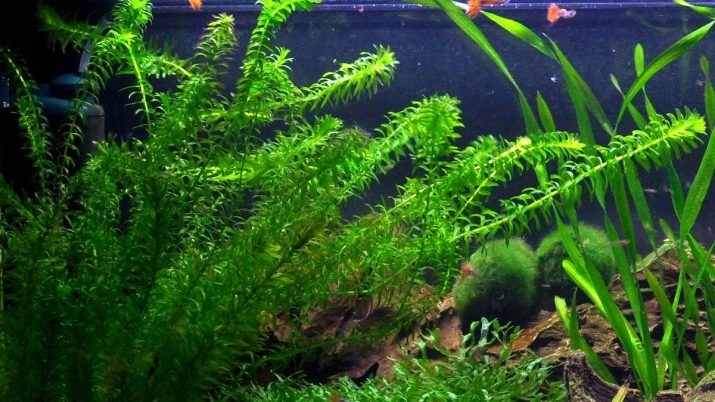
Each variety has its own characteristics. For example, leafy elodea is distinguished by its massiveness, large volume, density, while the jagged appearance is lighter and more airy, therefore it is this kind of species that is recommended to be planted in aquariums containing small fish that are not able to swim through heavy thickets. At the same time, the leafy variety is a good water filter, but her jagged rival it is not able to fully improve the microclimate and is used mainly for decorative purposes.
The “golden mean” in terms of density is elodea denza. It is characterized by a rich dark green color and thickets of medium density. As for the Canadian variety, it is famous for its ability to develop equally actively in both cold and warm bodies of water.
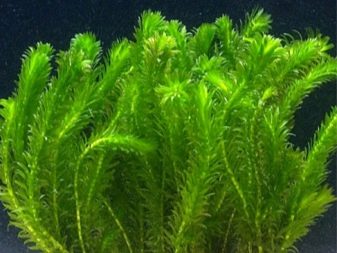
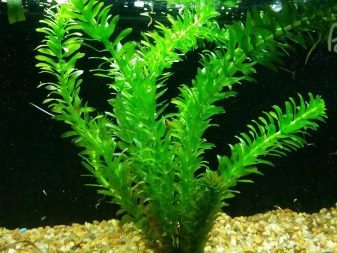
Application
In artificial and natural reservoirs, this plant is planted for landscaping and purification. Leaves release oxygen into the water, and also become the main decoration of a home aquarium. For large reservoirs, it is not always recommended to use elodea, since it is still not capable of cleaning a large area, and it will be very problematic to remove it later.
Another use for this plant is as a pet food. Especially scalars and goldfish love to feast on the thickets of elodea. For fry and small fish species, such as guppies and swordtails, algae provide a convenient hiding place. Where elodea grows, a good ecology is always maintained, since it is capable of absorbing salts of heavy metals and radionuclides.
In addition, Elodea can inhibit the growth of other aquarium plants. For example, overgrown filamentous fibers or black beard will stop their development if elodea thickets appear in the aquarium.
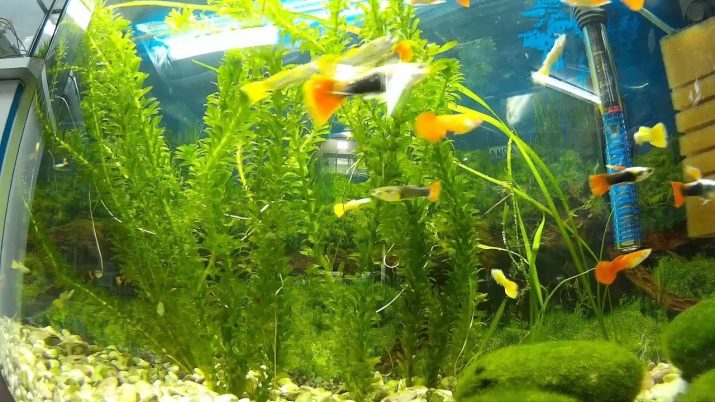
Conditions of detention
In order for a culture to feel comfortable, it is important to create suitable conditions for it. Aquarists recommend listening to the following tips:
- ensure the water temperature is + 14– + 23 degrees; if the water is warmer, then the intensity of development will slow down, and when grown in cold water, Elodea will begin to prepare for wintering;
- This plant is not picky about the hardness of water, but there is one caveat: it does not like a sharp change in the previous hardness. Moreover, the vegetation will withstand the migration from hard to soft water, but otherwise it will feel very bad.
- Plant elodea if you are treating fish with salt supplements. This plant does not like salt in water.
- Keep your water clean. Turbidity can interfere with the penetration of the sun on the leaves of Elodea, and a lack of light can even lead to the death of this culture. Daylight hours should be 10-12 hours.
- Do not plant plague in a fast-flowing aquarium, otherwise it will grow in only one corner, which will disturb the aesthetic harmony of the aquarium's appearance.
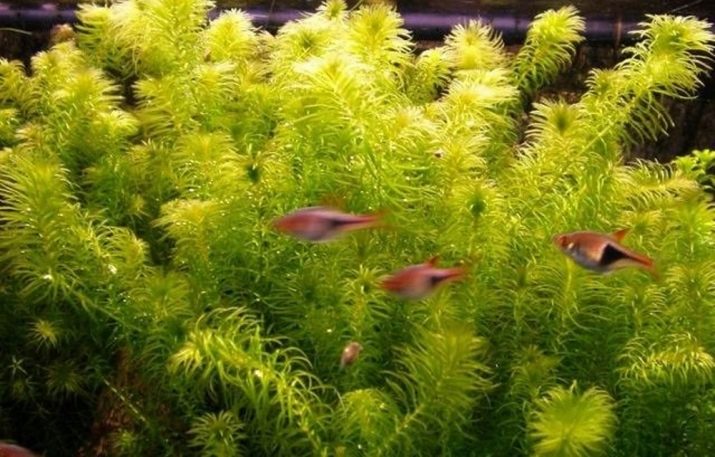
Care
Check out our tips for caring for this aquarium plant.
- Follow the planting rules. Lower the lower end of the shoot to the bottom in the ground and press it with stones. White filamentous roots will appear very quickly and will fix firmly on the bottom. For planting, give preference to soil containing a large amount of lime - this substance will allow the plant to root as firmly as possible.
- Thin the elodea in the summer. The fact is that at this time it grows too actively and quickly fills the entire space of the aquarium. Due to the abundance of vegetation, aquarium inhabitants may feel uncomfortable, so it is recommended to thin out the plant, removing small areas of vegetation.
- When you need to transplant elodea from soft to hard water, increase its daylight hours to 16 hours. This is necessary for the plant to quickly get used to new conditions and restore the volume of green mass lost during adaptation.
- In winter, always use artificial lighting, as there is not enough natural light during this period. This can lead to stunted development and plant diseases.
- Replace 1/5 of the volume of water weekly, so that the aquarium is always clean and the plant feels comfortable.
- You do not need to fertilize elodea. She uses recycled waste from the inhabitants of the aquarium as a top dressing.
- Being a quality filter, Elodea accumulates dirt particles on the leaves and stems, so it is periodically required to rinse it under running water.

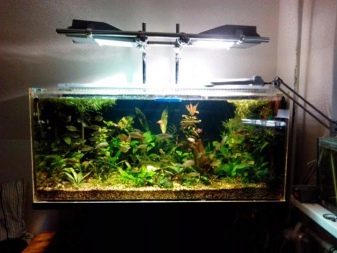
Reproduction
When breeding elodea, problems usually do not arise. For planting, you need a twig with a length of at least 20 cm, which must be strengthened in the ground. Some aquarists do it even easier and just put one shoot in free swimming. The twig quickly sprouts, which become independent and begin to grow throughout the territory. Knowing the activity and unpretentiousness of the plant, it is important to weed the elodea.
If you need to plant a plant in an open reservoir, then it is better to choose a fast flow for this. When planting elodea in stagnant water, the respiration of algae will provoke the formation of an abundance of carbon dioxide, which slows down the development of plants. The plant is able to reproduce by seeds, but this is possible only in nature.
In the home aquarium, elodea is used as a natural filter, it absorbs fish waste and purifies the water. In winter, its growth slows down slightly, and in spring the plague may even go into hibernation due to a lack of sunlight and low water temperatures. In summer, the plant's activity resumes again. Be careful when relocating elodea, as its stems and leaves are fragile. When thinning and pruning stems for planting, remove the specimen from the water.
The fact is that its juice released during cutting is poisonous to aquarium inhabitants and other algae.
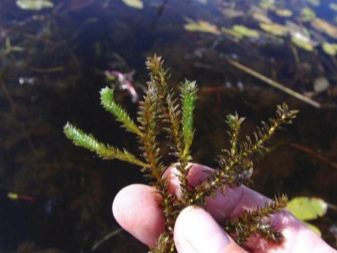
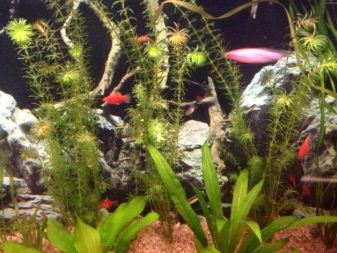
Diseases
Elodeya is distinguished by a rather strong immunity, so she practically does not suffer from various ailments. Health problems can occur only in the absence of lighting and if the water temperature is not observed. In this case, the leaves will be covered with brown spots and then fall off. If conditions remain unfavorable, then Elodea will die.
Despite being disease-resistant, Elodea itself can infest fish in an aquarium. This happens if you take a plant for planting from a natural reservoir. An infection can be transferred on the leaves and stems, which will cause the death of the entire aquarium world.
To avoid such situations, purchase the plant from trusted pet stores or reliable aquarists.
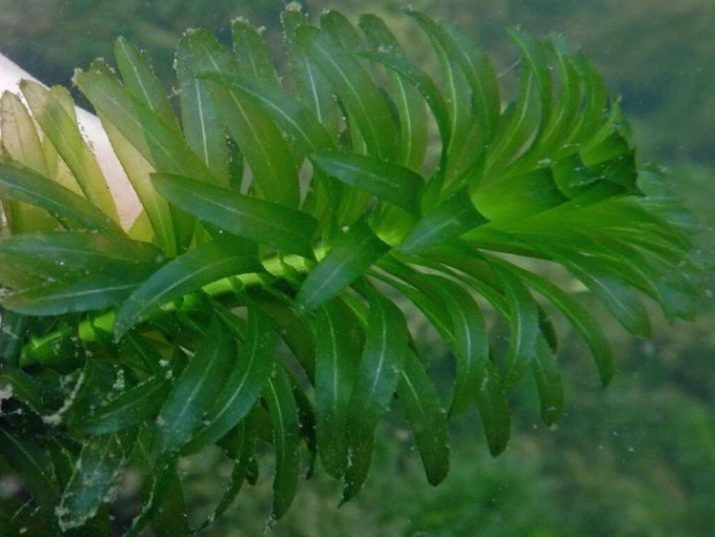
For even more information on the aquarium elodea, see the next video.








